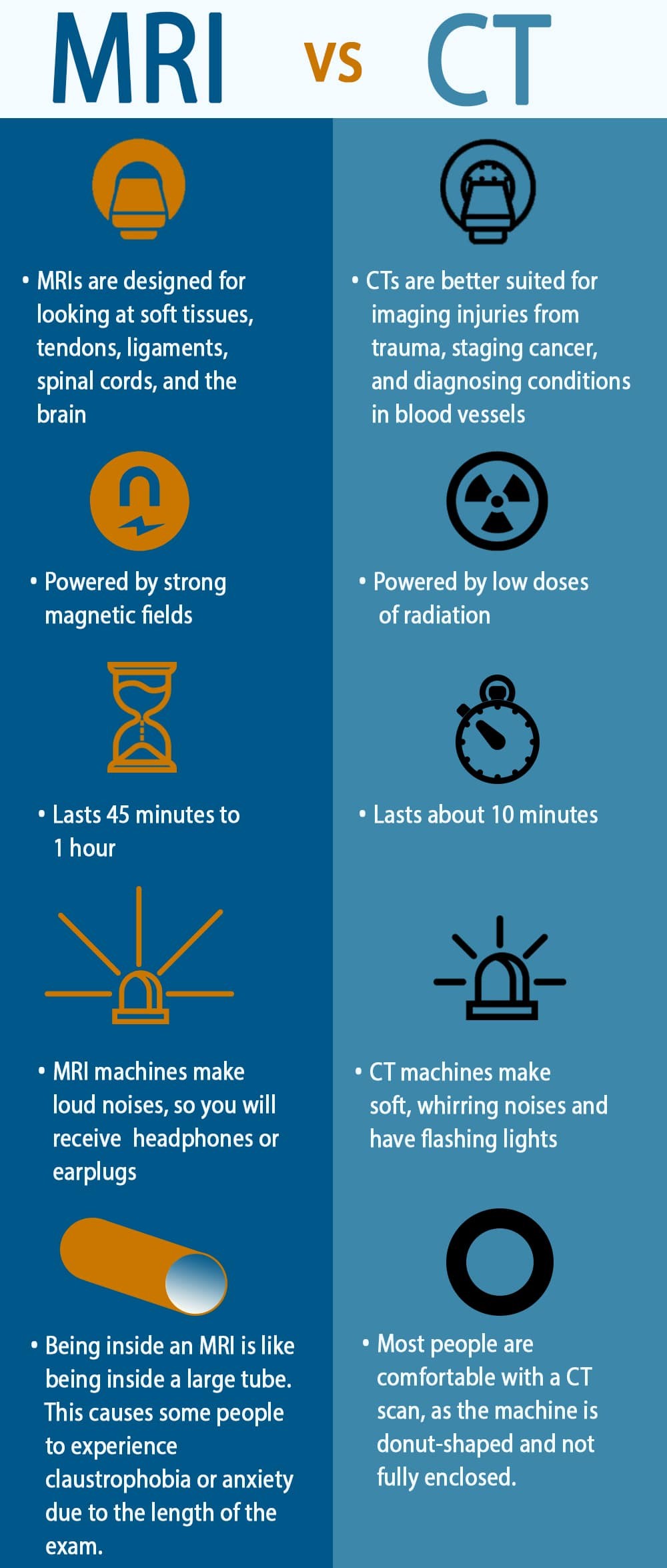
Contents
- 1 CT Scan vs. MRI
- 1.0.1 How does an MRI (magnetic resonance imaging) scan work?
- 1.0.2 Which one is safer, CT or MRI?
- 1.0.3 Are CT scan or MRI painful?
- 1.0.4 What diseases or conditions can CT and MRI diagnose?
- 1.0.5 Can you see cancer on a CT scan or MRI?
- 1.0.6 Can CT scan or MRI see bones and soft tissues?
- 1.0.7 What can a CT scan show that an MRI cannot?
- 1.0.8 Which costs more, CT scan or MRI?
- 1.0.9 Why would you need to have an MRI after having a CT scan?
- 1.0.10 Who should not get an MRI?
CT Scan vs. MRI
A CT scan takes multiple X-rays at varying angles to create a three-dimensional image of an organ system. The computer synthesizes these X-rays to form a model of internal organs.
How does an MRI (magnetic resonance imaging) scan work?
MRIs use a superconducting magnet and radiofrequency waves. The magnetic field aligns atoms in a north or south position, while some atoms continue spinning normally. When radiofrequency is added, unmatched atoms spin in the opposite direction. When radiofrequency is turned off, unmatched atoms return to the normal position, emitting energy. The computer converts this signal into an image using mathematical formulas.
Which one is safer, CT or MRI?
In general, both CT and MRI scans are relatively safe. However, MRI scans should not be done on patients with aneurysm clips unless the clips are known to be MRI safe, as they can cause bleeding in the brain. Certain cardiac pacemakers or defibrillators can malfunction due to the magnets in an MRI. Any metal objects that can react to a magnetic field, such as metal shavings or certain oxygen tanks, should be kept away from MRI machines to prevent injury or death. CT scans do not have these issues but expose the patient to radiation and may not be recommended during pregnancy.
Are CT scan or MRI painful?
CT scans are quick, painless, and provide detailed information to doctors. MRI scans are also painless and offer more detailed soft tissue images. However, MRI scans take longer and can cause anxiety, especially in claustrophobic patients. Patients must remain still during the procedure. Open MRIs are available but do not provide detailed images like regular MRIs.
What diseases or conditions can CT and MRI diagnose?
CT scans help diagnose conditions like strokes, head trauma, abdominal pain, unexplained pain, and fractures in bones. MRI scans provide detailed images of organs, soft tissues, ligaments, and can identify herniated discs in the spine, among others.
Can you see cancer on a CT scan or MRI?
Cancer is diagnosed through tissue biopsy. CT and MRI scans can show masses that may be tumors but are not definitive for cancer diagnosis. They can guide oncologists in determining if and where cancer has spread.
Can CT scan or MRI see bones and soft tissues?
Both CT and MRI scans can see bones and soft tissues, but MRI provides more detailed images of soft tissues.
What can a CT scan show that an MRI cannot?
CT scans are rapid and used in emergency situations, while MRI scans provide more detailed images and are used in non-emergency situations to analyze brain and soft tissues.
Which costs more, CT scan or MRI?
MRI scans are about twice as expensive as CT scans, especially when a contrast dye is used.
Why would you need to have an MRI after having a CT scan?
A CT scan provides limited detail for soft tissue issues. An MRI is ordered when a more detailed picture is needed to assess damage to ligaments and other soft tissues, especially in cases of sports injuries.
Who should not get an MRI?
Some metal implants or orthopedic hardware are not compatible with MRI. Patients with metal fragments in their bodies should have an X-ray before an MRI. Examples of what is not compatible with MRI include artificial heart valves, joint replacements, brain aneurysm clips, and pacemakers. Pregnant women are advised against MRI scans, especially in the first three months. Similar restrictions apply to CT scans for pregnant women. Patients’ weight or size may also limit CT and MRI scans.
By clicking Submit, I agree to the MedicineNet’s Terms & Conditions & Privacy Policy and understand that I may opt out of MedicineNet’s subscriptions at any time.


